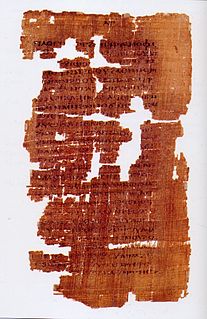
Judas Iscariot was a disciple and one of the original Twelve Apostles of Jesus Christ. According to all four canonical gospels, Judas betrayed Jesus to the Sanhedrin in the Garden of Gethsemane by kissing him and addressing him as "rabbi" to reveal his identity in the darkness to the crowd who had come to arrest him. His name is often used synonymously with betrayal or treason. Judas's epithet "Iscariot" most likely means he came from the village of Kerioth, but many other possibilities have been suggested.

The Keys of the Kingdom is a 1941 novel by A. J. Cronin. Spanning six decades, it tells the story of Father Francis Chisholm, an unconventional Scottish Catholic priest who struggles to establish a mission in China. Beset by tragedy in his youth, as a missionary Chisholm endures many years of hardship, punctuated by famine, plague and war in the Chinese province to which he is assigned. Through a life guided by compassion and tolerance, Chisholm earns the respect of the Chinese—and of fellow clergy who would mistrust him—with his kindly, high-minded and courageous ways.

Mark 14 is the fourteenth chapter of the Gospel of Mark in the New Testament of the Christian Bible. It contains the plot to kill Jesus, his anointing by a woman, the Last Supper, predictions of his betrayal, and Peter the Apostle's three denials of him. It then begins the Passion of Jesus, with the garden of Gethsemane and Judas Iscariot's betrayal and Jesus' arrest, followed by Jesus' trial before the Sanhedrin and Peter's denials of Jesus.

The Gospel of Judas is a non-canonical Gnostic gospel. The content consists of conversations between Jesus and Judas Iscariot. Given that it includes late 2nd-century theology, it is widely thought to have been composed in the 2nd century by Gnostic Christians, rather than the historic Judas himself. The only copy of it known to exist is a Coptic language text that has been carbon dated to 280 AD, plus or minus 60 years. It has been suggested that the text derives from an earlier manuscript in the Greek language. An English translation was first published in early 2006 by the National Geographic Society.
The Miracle Maker is a 1999 British-Russian-American stop motion-animated film about the life of Jesus Christ, through the eyes of Tamar; the terminally ill daughter of Jairus, a priest in Capernaum. Hand-drawn animated cartoons are used to distinguish flashbacks, parables, stories, spiritual encounters and visions from the main plot, which is all in stop motion.

The Marriage of Figaro is a comedy in five acts, written in 1778 by Pierre Beaumarchais. This play is the second in the Figaro trilogy, preceded by The Barber of Seville and followed by The Guilty Mother.

The Guilty Mother, subtitled The Other Tartuffe, is the third play of the Figaro trilogy by Pierre Beaumarchais; its predecessors were The Barber of Seville and The Marriage of Figaro. This was the author's last play. It is rarely revived. Like the earlier plays of the trilogy it has been turned into operatic form, but it has not entered the general opera repertoire.

Mary Eleanor Bowes, Countess of Strathmore and Kinghorne was a notable member of the British aristocracy during the Georgian period.

The Citadel is a 1983 BBC television adaptation written by Don Shaw from A. J. Cronin's 1937 novel The Citadel. It was produced by Ken Riddington. The drama was directed by Peter Jefferies and Mike Vardy.
The Guiding Light was an American television soap opera.

The Man Within (1929) is the first novel by author Graham Greene. It tells the story of Francis Andrews, a reluctant smuggler, who betrays his colleagues, and the aftermath of his betrayal. It is Greene's first published novel..

Mary Gleed Tuttiett, better known by the pen name Maxwell Gray, was an English novelist and poet best known for her 1886 novel The Silence of Dean Maitland.
Joan Fitzgerald, Countess of Ormond, Countess of Desmond, was an Irish noblewoman and heiress, a member of the Old English FitzGerald family, who were also known as the "Geraldines".

The Last Supper of Jesus and the Twelve Apostles has been a popular subject in Christian art, often as part of a cycle showing the Life of Christ. Depictions of the Last Supper in Christian art date back to early Christianity and can be seen in the Catacombs of Rome.
Anjo Mau is a remake of the original 1976 Brazilian telenovela that was produced and broadcast by TV Globo between September 8, 1997, and March 27, 1998. It was produced in 173 chapters.

Doomsday is a 1928 American romance drama silent film directed by Rowland V. Lee and starring Florence Vidor and Gary Cooper. Written by Julian Johnson, Donald W. Lee, and Doris Anderson, based on the 1927 novel Doomsday by Warwick Deeping, the film is about a woman who marries a wealthy landowner to escape her life of poverty, leaving behind the handsome farmer she truly loves. Produced by Jesse L. Lasky, Rowland V. Lee, Hector Turnbull, and Adolph Zukor for Paramount Pictures, Doomsday was released on February 18, 1928 in the United States.

La señora de Cárdenas is a Venezuelan telenovela written by José Ignacio Cabrujas and produced by RCTV in 1977. The telenovela became the first in a series of telenovelas referred to as the cultural telenovela because they reflected the reality of Venezuelans in areas such as marriage and intimate family life.













